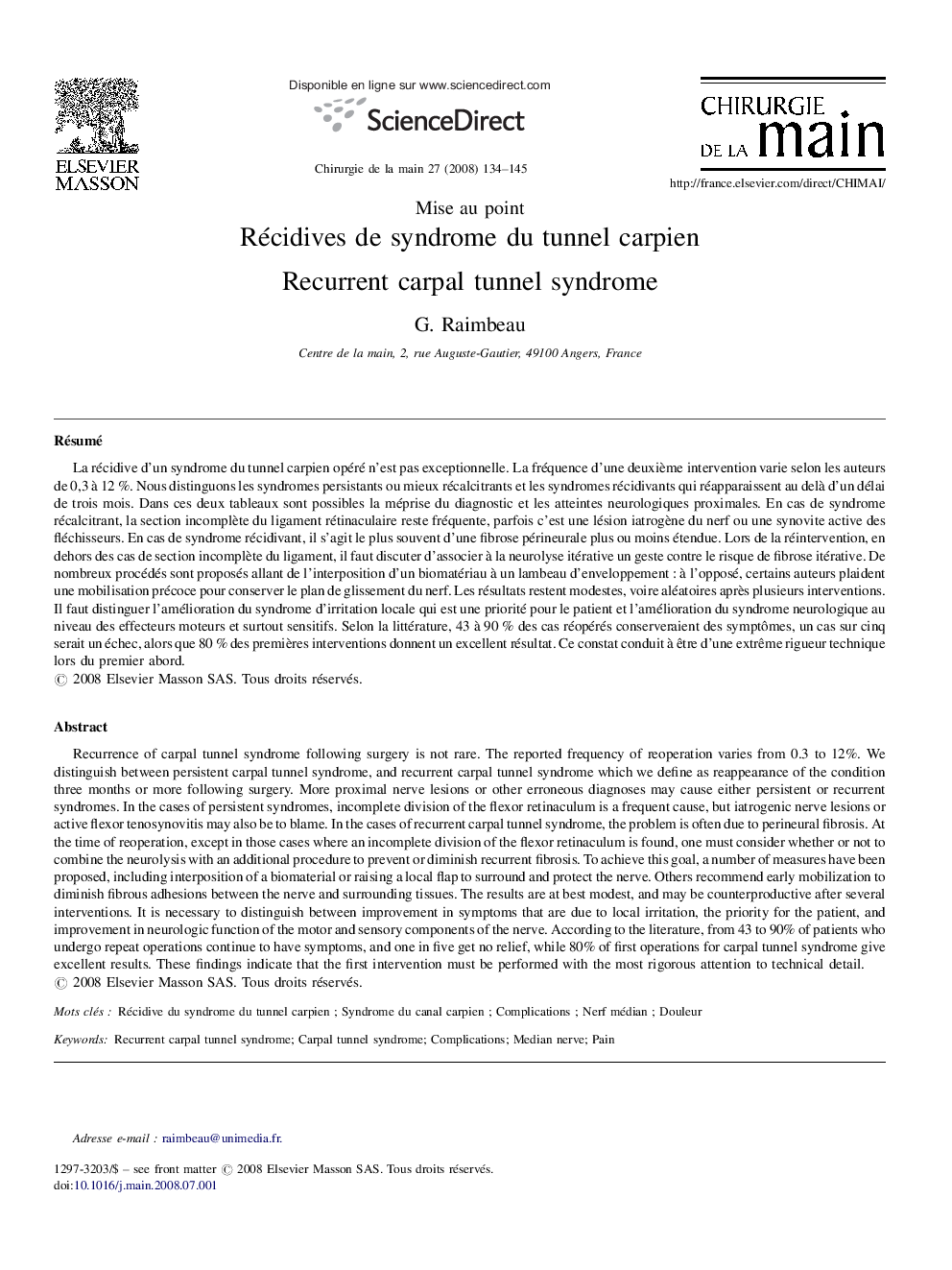| Article ID | Journal | Published Year | Pages | File Type |
|---|---|---|---|---|
| 4049856 | Chirurgie de la Main | 2008 | 12 Pages |
RésuméLa récidive d’un syndrome du tunnel carpien opéré n’est pas exceptionnelle. La fréquence d’une deuxième intervention varie selon les auteurs de 0,3 à 12 %. Nous distinguons les syndromes persistants ou mieux récalcitrants et les syndromes récidivants qui réapparaissent au delà d’un délai de trois mois. Dans ces deux tableaux sont possibles la méprise du diagnostic et les atteintes neurologiques proximales. En cas de syndrome récalcitrant, la section incomplète du ligament rétinaculaire reste fréquente, parfois c’est une lésion iatrogène du nerf ou une synovite active des fléchisseurs. En cas de syndrome récidivant, il s’agit le plus souvent d’une fibrose périneurale plus ou moins étendue. Lors de la réintervention, en dehors des cas de section incomplète du ligament, il faut discuter d’associer à la neurolyse itérative un geste contre le risque de fibrose itérative. De nombreux procédés sont proposés allant de l’interposition d’un biomatériau à un lambeau d’enveloppement : à l’opposé, certains auteurs plaident une mobilisation précoce pour conserver le plan de glissement du nerf. Les résultats restent modestes, voire aléatoires après plusieurs interventions. Il faut distinguer l’amélioration du syndrome d’irritation locale qui est une priorité pour le patient et l’amélioration du syndrome neurologique au niveau des effecteurs moteurs et surtout sensitifs. Selon la littérature, 43 à 90 % des cas réopérés conserveraient des symptômes, un cas sur cinq serait un échec, alors que 80 % des premières interventions donnent un excellent résultat. Ce constat conduit à être d’une extrême rigueur technique lors du premier abord.
Recurrence of carpal tunnel syndrome following surgery is not rare. The reported frequency of reoperation varies from 0.3 to 12%. We distinguish between persistent carpal tunnel syndrome, and recurrent carpal tunnel syndrome which we define as reappearance of the condition three months or more following surgery. More proximal nerve lesions or other erroneous diagnoses may cause either persistent or recurrent syndromes. In the cases of persistent syndromes, incomplete division of the flexor retinaculum is a frequent cause, but iatrogenic nerve lesions or active flexor tenosynovitis may also be to blame. In the cases of recurrent carpal tunnel syndrome, the problem is often due to perineural fibrosis. At the time of reoperation, except in those cases where an incomplete division of the flexor retinaculum is found, one must consider whether or not to combine the neurolysis with an additional procedure to prevent or diminish recurrent fibrosis. To achieve this goal, a number of measures have been proposed, including interposition of a biomaterial or raising a local flap to surround and protect the nerve. Others recommend early mobilization to diminish fibrous adhesions between the nerve and surrounding tissues. The results are at best modest, and may be counterproductive after several interventions. It is necessary to distinguish between improvement in symptoms that are due to local irritation, the priority for the patient, and improvement in neurologic function of the motor and sensory components of the nerve. According to the literature, from 43 to 90% of patients who undergo repeat operations continue to have symptoms, and one in five get no relief, while 80% of first operations for carpal tunnel syndrome give excellent results. These findings indicate that the first intervention must be performed with the most rigorous attention to technical detail.
